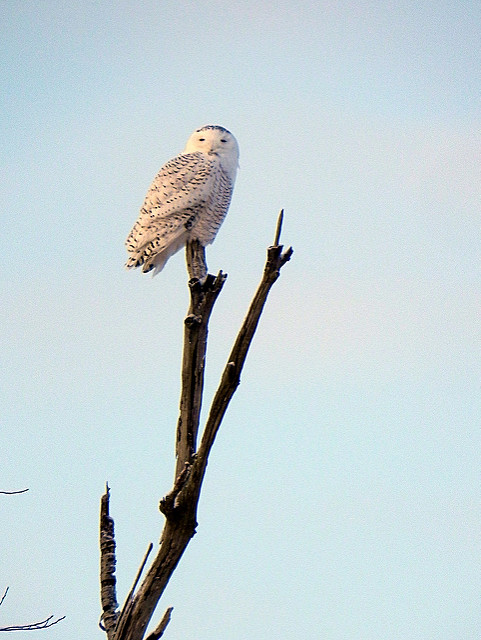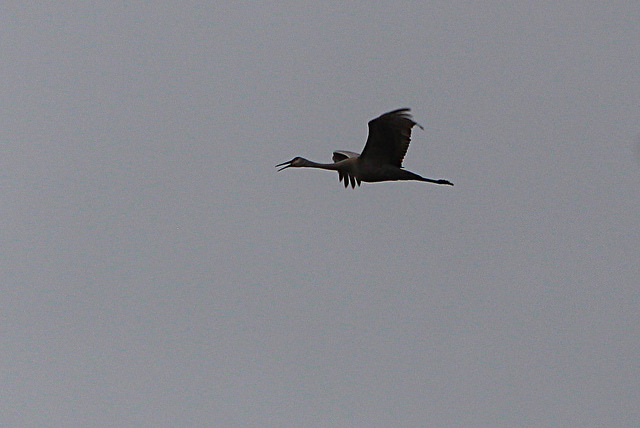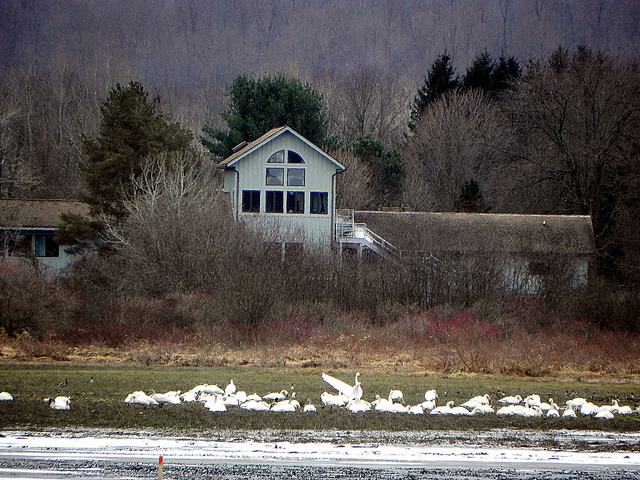
Snowy Owls are moving into the area because the population of their food in the north has crashed. Photo by Jeff Tome
It was one of those days when I didn’t want to go outside. The weather was frigid with that special damp cold when the temperature hovers in the upper 20’s and wet snow is falling, the kind of cold that seeps through layers of clothes and right down to your bones. New snow was unplowed and the road slick as big wet flakes made the world hard to see.
Regardless, it was a day that I had said I would go out and I would. Rising with the sun, I put on snow pants, thick socks, boots, hat and gloves, and headed out the door into the gray early morning light. It was the morning of the Warren Christmas Bird Count.
A small group of us met by the Eagles Club in Warren and split up from there, going to various places to count birds. I tucked my binoculars under my coat to keep them clear of snow and searched the bushes for birds.
The Christmas Bird Count is the longest running citizen science project in the world. Around forty people participate in Warren’s Christmas Bird count each year. This provides bird scientists, known by the fancier name of ornithologists, information on where birds are that day for years.
The Warren count started with one individual in 1940, who spent eight hours searching for birds. Over the years, more and more people started to help, until over 100 hours of time is spent that day searching for and counting birds.
It’s easy to stop reading here, make a joke about how odd those bird people are to go out and search for birds in the cold and move on with your life, but that would be a mistake.
The Christmas Bird Count is one of the only ways that long term information about the world is kept. That information is important, because it is the difference between telling stories about how things were different when your were a kid compared to having information to back that up.
Do you remember more Ruffed Grouse and quail years ago compared to now? Me too, but I would have to look it up in the Christmas Bird Count database to verify if that’s true. It makes the story more compelling.
Back when I was young, I only learned the names of the really common backyard birds: robins, cardinals, chickadees and birds like that. My backyard also had a large number of a bird called a Brown Thrasher. As a kid, I noticed there was maybe one Brown Thrasher for every two robins. They were an every day kind of bird in the summer. It’s weird to me that a bird that was common to me as a child is a bird that my own children have never seen.
Christmas Bird Count data shows that the number of Brown Thrashers is down significantly. Other sources say the population is down 41%. I would have expected it to have dropped more than that, but perhaps I grew up in the perfect Brown Thrasher habitat. This is why memory can be an inexact way to recall the past and compare it to the future. Moving from one place to another can have a significant impact on what you notice.

Some birds, like this Sandhill Crane, have been expanding their range. Citizen science projects help track where these birds end up in winter. Photo by Jeff Tome
The Christmas Bird Count has its origins in the Christmas side hunt of the 1800s. Hunters would go out and whoever brought back the biggest pile of animals won. In 1900, early members of the National Audubon Society proposed a Christmas Bird Census. Many people went out across the continent and found 90 species of birds.
This Information that is collected gives scientists a snapshot of where birds end up in winter. This area is South to many birds who fly here for the mild winters. Mild, that is, compared to the -30 degree temperatures they would face at their nesting grounds in the arctic tundra. The area becomes deluged with odd birds that many never notice: Rough-legged Hawks, pipits, Tundra Swans, White-throated Sparrows, and other birds that only arrive with the cold breath of winter.
Included in these are birds that only fly down every few years. This year, ornithologists predict that Snowy Owls will once again fly into the region. The prediction was not made based on weather, but because Snowy Owls rely on a tiny rodent called a vole. When the vole population crashes, which it just did in Canada, the Snowy Owls move south to find food.
These casual, infrequent migrations are known as irruptions. The Christmas Bird Count has been instrumental in understanding that these are continent wide phenomena and not just an odd occurrence in one area.
Other birds irrupt as well. This year, Red-winged Crossbills, a small bird with a scissor-like beak, are also irrupting because the pine seed crop they depend on has failed. Some years have Evening Grosbeaks, which look sort of like giant mutant goldfinches with cardinal beaks, arriving en masse at feeders.
Citizen science projects collect the information that verifies the gut feelings we have about how the world has changed. The Christmas Bird Count is just one of those, but there are many. If you have a passion for anything in the outdoors, type that passion and the word “citizen science” into a search engine on a computer. You might be surprised at how you can help us gain a better understanding of the world we live in.
The Christmas Bird Count happens on December 16 in Warren and December 17 in Jamestown. Call Audubon if you are interested in participating and we can help set you up with a count area. This can be as small as your backyard, which is what my daughter counts, or a longer walk or drive to various spots to count.
Jeff Tome is a naturalist at the Audubon Community Nature Center at 1600 Riverside Road, Jamestown NY. More information about Audubon can be found by going online at auduboncnc.org or by calling them at 716-569-2345.


Recent Comments